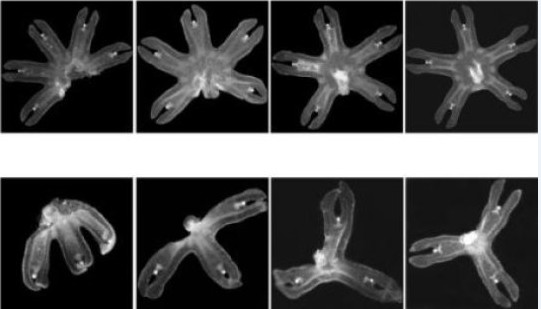Wonders of Creation
Jellyfish Discovery: The Astonishing Self-Healing Power of Symmetrization
Scientists uncover how jellyfish reorganize their bodies after injury — offering hope for breakthroughs in regenerative medicine
- Hidabroot
- |Updated
 A jellyfish split in two: both the top and bottom parts reorganized themselves symmetrically
A jellyfish split in two: both the top and bottom parts reorganized themselves symmetricallyResearchers at Caltech University in Pasadena, California, discovered that jellyfish, even after losing some of their arms, can reorganize their bodies to return to optimal function.
The discovery began in the spring of 2013 when Michael Abrams, a biologist at the university, cut two arms off a young jellyfish.
At first, the research team assumed the jellyfish was regenerating new arms, as some marine creatures do after losing limbs. But in fact the jellyfish reorganized its remaining six arms, spreading them evenly around its body until it looked perfectly symmetrical again. To an untrained eye, there was no sign that the jellyfish had suffered any injury at all.
The Phenomenon of "Symmetrization"
The purpose of this reorganization was clear to the scientists: a symmetrical body is essential for a jellyfish to swim and move effectively. How it achieved this was the real mystery.
The team identified a previously unknown process, which they named “symmetrization.” Since jellyfish are often injured in the wild, this ability is a highly effective survival strategy, allowing them to heal without regenerating new limbs.
 A jellyfish split in two: both the top and bottom parts reorganized themselves symmetrically
A jellyfish split in two: both the top and bottom parts reorganized themselves symmetricallyFurther experiments showed the same behavior across many jellyfish. Within 12 hours to 4 days, each reorganized itself into a new, balanced shape. To test the mechanism behind this, scientists experimented with muscle activity. When jellyfish were given drugs that relaxed their muscles, they were unable to symmetrize, while stimulating the muscles sped up the process.
Jellyfish achieve symmetry by using their own muscle contractions to push and reposition the remaining arms into new locations. Though missing limbs, the jellyfish still functioned normally.
Potential for Regenerative Medicine
The researchers believe that this newly discovered process of symmetrization may inspire breakthroughs in regenerative medicine. They suggest that some parts of the human body might not need to be replaced entirely to restore function — perhaps reorganization, rather than regeneration, could be the key.

